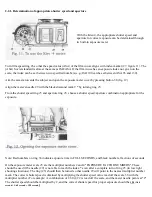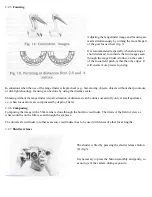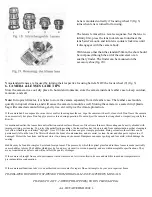
Lens is mounted correctly if focusing wheel 9 (fig. 3)
turns when lens is turned for focusing.
The lens is removed in a reverse sequence. Set the lens to
infinity first, press the lens lock release found near the
lens barrel's mount, and turn lens counter clockwise until
it disengages with the camera body.
With lenses other than the standard 50mm, the shot should
be composed through the aid of the universal or an
auxiliary finder. The finder can be mounted on the
accessory shoe (fig. 20).
Non-standard lenses are focused by turning their respective focusing barrels, NOT the focus wheel (9) (fig. 3)
6. CAMERA & LENSES CARE TIPS
Store the camera in a cool, dry place. In humid environments, store the camera inside its leather case to keep out dust,
moisture, and salt.
Note:
In tropical climates, it is better to store the camera separately from its leather case. The leather case moulds
quickly in tropical climates, and will cause the camera to mould as well. Storing the camera in a sealed vinyl plastic
bag with some desiccants (Silica gel, dry rice, etc) will give the it more protection.
If the camera had been exposed to rain or mist, or after shooting near the sea, wipe the camera with a soft, clean cloth. Don't leave the camera
in an excessively hot place. Don't apply excessive force during operation. Do not subject the camera to strong shock or impact (especially the
Kiev-4).
As mentioned earlier, the lenses have antireflection coated surfaces. Because of its extreme thinness, this coating can be easily abraded with
improper wiping or cleaning. To protect the antireflection coatings, the lens surface has to be protected from contamination so that cleaning is
less often. Attaching a colourless "skylight" 1A or UV filter on the lens can give it ample protection. Being colourless, these filters can be
permanently left on the lens. The filter will absorb the brunt of contamination, and are easier
to
clean. Easier and cheaper to replace too, if
damaged. Protect the lens from, and do not store it in, a damp environment. Dampness can cause spotting and lens mold, which damage the
coating.
Bubbles may be found in complex Soviet and foreign lenses. The process by which the optical glass found in these lenses is made inevitably
causes bubbles to form The bubbles which may be found are very small in size and quantity, and are within acceptable specifications. They
are not considered as defects and will not affect the quality of images.
If the camera is brought from a cold environment into a warmer one, let it warm first in its case and stabilize to ambient temperatures to
prevent moisture condensation.
If the camera malfunctions, take it to an authorized service center for repair. Do not attempt to do your own repairs at home.
TRANSLATED BYANDREY OSTAPENKO FROM ORIGINAL MANUFACTURER'S
MANUALS.
THANKS TO JAY Y. JAWER (PHILIPPINES) FOR IN TRANSLATING.
A A. OCTAITEHKO 2002 r.













